It isn't yet clear to me whether Munson's system was ever sold or used commercially. If it was used, it must have been in a very small way which has left no trace in the historical record. We know of it only from patents and preliminary reports.
Richard E. Huss devotes two pages to this machine as it was described by 1889 (that's a long entry for Huss) in The Development of Printers' Mechanical Typesetting Methods, but shows no photograph of it. It is his Catalog No. 89. {Huss 1973} However, John S. Thompson, in his History of Composing Machines does not identify it as one of the "complete machines" that form the core of his survey. He merely lists Munson's "plan" in 1882 to perform justification by tape. {Thompson 1904}, pp. 61-62. Even if Munson's machines were not successful, they remain interesting for the number of technologies and issues that they anticipated (including punched tape control, tape editing, unit-set composition, chord keyboards, and the long-distance (telegraphic) transmission of typeset texts.
The most distinctive feature of Munson's approach was the use of a perforated tape prepared at a keyboard which was separate from the type machine itself. In this he anticipated the Lanston Monotype (in development from 1885 to ca. 1900) but was in turn anticipated by Mackie's Steam Composing Machine (1867).
He also incorporated, integrally and apparently nearly from the start of his work, the telegraphic transmission of composed text. In this respect he anticipated the Teletypesetter of 1928 (and even then the TTS took a while to catch on; the Associated Press did not adopt it until around 1951). His approach indicates an awareness of the issues of synchronization which plagued all pre-Teletype attempts at teleprinting, and he proposes a plausible solution.
Munson's first machines seem to have been composing machines (only) with associated tape and telegraphic transmission systems. Justification was by hand. By 1891 he was claiming both machine justification and distribution.
Moreover, Munson's system (or series of systems as they developed) occupy a complicated position in the history of unit-set type (a subject of interest for several reasons: its use in types for hand composition by Linn Boyd Benton, its use in machine composition by the Lanston Monotype system, and its use in remote machine composition by the Teletypesetter).
Munson's patents do not claim the use of unit-set type. They do, however, demonstrate the difficulties of applying Munson's system to ordinary or non-unit-set type. His analysis of "Unit-Made Type Bodies" submitted to The Inland Printer in 1889 claims that he had been working on them in the early 1880s. Later reports indicate that at some point in the late 1880s his system adopted unit-set types. But from at least 1891, Munson abandoned unit-set type.
From the point of view of business and economic history, Munson's system is barely a footnote. For the engineering historian, however, it is interesting because of the number of later significant problems and solutions that it anticipates in machine composition, tape control, keyboarding, and teleprocessing. Munson's system may have touched on more of the issues of 20th (and 21st) century (tele)composing machinery than any other 19th century approach.
There are also several tidbits in it which are probably red herrings. Munson was a court stenographer, just like James O. Clephane (who started Mergenthaler on the path to the Linotype). Munson also clearly knew of Mergenthaler's early work in 1885; it may or may not have been a coincidence that he resumed his own work at about this time. Munson later occupied offices in the Tribune Building in New York - and as Linotype enthusiasts know, Whitelaw Reid, owner of the New York Tribune was at one time the controller of the Linotype syndicate and he became Ottmar Mergenthaler's bitter enemy. (Reid had a long history of interest in composing machinery to further reduce the wages he needed to pay in his non-union shop.) Finally, in at least one public demonstration of his keyboard, tape, and transmission mechanisms Munson used not his own typesetter but rather the Thorne. There is, however, at present insufficient evidence to speculate further on any of these possible links.
The New International Encyclopedia contained a brief entry on Munson:
"Munson, [phonetic spelling omitted], James Eugene (1835 - ). An American inventor, born at Paris, Oneida County, N. Y. He studied for a time at Amherst, then removed to New York City, where he became a court stenographer, a position which he held for more than thirty years. He formated the Munson system of stenography, and automatic typesetting machine, and a mechanism of operating typewriter machines by telegraph, and published a number of books on phonography." ( {NEI 1911}, p. 132)
Munson was also the editor of Munson's Phonographic News and teacher, a journal devoted to shorthand writing.
Munson's system is also probably more difficult for us to understand today than it was at the time. To someone of 1882, it might seem strange, but they would approach it without preconceptions. In a way, now, we know too much.
In 1881, Munson patented a device that in today's terminology we would call a "chord keyboard." That is, the input to the device consisted of a set of keys (ten of them) which when pressed in any of the possible combinations available to a ten-fingered human would produce a unique output signal. The output signal could be either mechanical (a pushed rod) or electrical.
To accomplish this, he used a mechanism inspired by the Jacquard loom, with "nest ... of movable thrust-pins arranged ... over a considerable area of rectangular form." But while the Jacquard loom used one card at a time as a data storage device (storing a pattern for the yarns of the warp of the fabric), Munson superimposed ten cards (each actuated by one of the ten keys of his machine). "A number of holes are perforated in each [card], and the holes are so distributed so that, hwoever the fingers are depressed, only one perfect hole will be presented quite through the entire set of cards, and only one. No combination of depressions of the fingers can open more than one hole. No combination of complete and perfect depressions of the fingers can be made which will not open one hole." It's really quite clever.
The design of this keyboard indicates that Munson understood combinatorics. He knew that it would produce (2^10 - 1) combinations (1023 combinations; he excluded the null case). This is interesting because his 1882 patent 320,271 for a tape system demonstrates that he did not understand binary encoding.
The keyboard is also interesting because it employs punched cards, but does not use them as information storage devices. Rather, they are used as decoders.
The patent does not specify a particular use for this keyboard, but indicates very broadly that it "is adapted for use with type-writing machinery or type-setting machinery" and that it "may also be used with mechanism for sending messages by telegraph." He does indicate, though, that in the patent itself he will "descibe it as applied to type-setting machinery. In his 1882 patent 320,271, he references this keyboard patent. It's reasonable to assume, then, that he was working on his typesetting system by 1881.
Munson's US patent 320,271 (issued 1885-06-16, but filed in 1882) specifies only a system of using tape for controlling typesetting machinery. It actually specifies not one but two kinds of punched tape, in an attempt to solve the problem of editing which is endemic to all composition systems.
The first punched tape is the one which contains the initial encoding of the text. Like later paper tape systems, it encodes characters by a set of transverse punches (or their absence) in a certain number of possible punch positions. In Munson's preferred tape, there are ten possible punch positions. But this is not 10-bit tape (or even 10-level tape in the pre-Shannon world of the Teletype/Teletypesetter). There is no indication in the patent that Munson understood binary coding. Each character position is punched with exactly three punches. (Munson rejects variable numbers of punches on the basis of the complexity of machinery.) So there are not (2^10 - 1) = 1023 possible character encodings here, but only 120. {10 choose 3}
This first tape is also interesting because while the encoding of a character's identity is digital, the encoding of its set width is analog. The position of the transverse punches along the tape is variable and proportional to the set width of the character.
This first tape is then, in Munson's system, proofread by a human proofreader, who annotates it by hand and sends it on to a justifier. My interpretation of Munson's patent is that the justifier is a human, not a machine. The justifier is equipped with apparatus to edit the tape (punch new holes, close up existing holes) and can thus implement the proofreader's corrections (though I believe that at this time the tape ceases to be strictly proportional to the types, as erased punches do not shorten it and inserted punches do not lengthen it). The justifier is also equipped with a "suitable scale or measure" to determine the point at which a line should break. The justifier must make "due allowance for said correction[s]" in doing this.
Having determined the line break, the justifier indicates it by inserting a "large low quad" code to serve as a newline indicator. The justifier then inserts (punches) the coding for spacing required to justify the line.
After justification, a second tape (an "operating tape") is punched. This tape may be used directly, or reproduced telegraphically (anticipating here the Teletypesetter). It differs from the first tape in that it has uniform spacing between the transverse punch positions. This makes it easier for the typesetting machine to read. The tape already has encoded on it all of the characters and spaces for a properly justified line.
Unit-Set type (q.v.) is a minor footnote in 19th century hand and machine composition but a major technical aspect of 20th century "hot metal" machine composition. The set width of each sort in traditional western type is in theory unique to that particular type - determined by the design and horizontal alignment of the letterform and the practices of the person running the caster. "Unit-set" types, by way of contrast, are types made to a more limited number of set widths, each of which is an integral multiple of some underlying unit. This simplification, of course, comes at the cost of having to redesign the visual appearance of the type so as to fit the unit system. In hand composition, it has been claimed that this increased the speed of composition by simplifying the task of justifying lines. In machine composition, it did clearly simplify the process of justification when that justification had to be calculated (vs., say, the direct analog method of the Shuckers/Linotype spaceband).
The first known unit-set system was one for machine composition by Wiberg in 1854. It is not clear that there were any other systems until H. H. Thorp patented a fairly complex system of unit-set types in two dimensions (to aid in setting curved or diagonal matter) in 1881. In 1883, Linn Boyd Benton introduced a system of unit-set types under the trade name "Benton's Self Spacing Type." In later machine composition, the Lanston Monotype (in development in the 1890s and introduced circa 1900) employed a fine-grained system of unit-set type. In direct use, the Linotype had no need for unit-set types (because of its analog spacebands), but unit-set types were introduced with the Teletypesetter in 1928 (to simplify composition on tape at the keyboard).
In all of this, Munson occupies an intermediate position which was clearly at times most uncomfortable.
His basic patents (see below) were filed in the 1881-1883 timeframe. They do not claim or use unit-set types. In fact, his patent 332,419 for a keyboard perforator (filed 1882) shows that Munson was aware of the additional complexity that non-unit-set type introduced into his system. Munson's interest must have waned, however, because none of these initial patents were issued until 1885.
In the meantime, Linn Boyd Benton was granted an extremely broad patent which secured for him the right to all unit-set type (US patent 290,201, issued 1883-12-18). In retrospect (as Munson was at pains to point out in his letter on "Unit-Made Type Bodies" sent the editor of The Inland Printer in 1889 ), the prior work of Wiberg (England, 1854) and Thorp (US, 1881) clearly invalidated Benton's patent. Whether this would have been an issue for the Lanston Monotype is perhaps a moot point, because Benton's patent expired in 1900, just as the Monotype came finally to market. For Munson in the late 1880s, however, this was a serious problem. It's easy to read his 1889 Inland Printer letter not as a technical study but as a sort of a shot across the bow in the public relations side of an anticipated patent fight with Benton over unit-set type. (To the best of my knowledge, no such fight ever occurred.)
It would appear that by around this time Munson had decided to simplify his system by adopting unit-set types. He proposes a system for them in his 1889 Inland Printer letter. We know, further, that he was using unit-set types in 1888. There is a report of this in The American Bookmaker in August 1888 . Munson himself indicates in his 1891 booklet The Munson Method of Power Type-Composition that his previous systems had used "unit-body type."
The reason that he gives for the need for unit-set type, however, is not the simplification of mechanism but the simplification of justifying. His machines through the 1880s involved justifying an initially punched tape by hand, using scales. In this situation, unit-set type would serve the same function in his tape-based system as it did in hand composition with Benton's Self Spacing Type: to speed justification by hand.
In that 1891 booklet, however, he indicates that "the machine itself will mechanically do the justifying, ... and it is no longer necessary that any of the operatives shall learn to read the composition on the ribbon, or that type of special make or peculiar body should be employed." (p. 12)
Munson never claimed to have preceded Benton in the use of unit-set type - only Benton was himself predated by Wiberg and Thorp. Moreover, Munson indicates that his own early efforts (presumably circa 1882/3) were unsuccessful due to the use of the wrong basis for a unit. It would seem, therefore, that Munson's verified use of unit-set types came only in machines in the circa-1888 timeframe. These were at best demonstration machines.
So if Munson's system is a footnote in the history of machine composition, his use of unit-set type is a footnote to a footnote. But it remains an interesting sub-footnote for at least two reasons: First, Munson seems to have been the earliest writer in America to investigate the history of unit-set type (if only to defend his own position). Second, his use of unit-set type in a tape-controlled composition system capable of being used over a telegraph - even if never quite brought to market - makes him a part of the prehistory of the Monotype, the Teletypesetter, and a great deal of the machine composition of the 20th century.
Note: None of Munson's patents were filed with accompanying models. The published records of the Smithsonian Institution (who now have the surviving models) also fail to indicate any models. {Janssen 2010} I have at present been unable to discover any illustrations of Munson's machines or portraits of Munson.

GB Patent 3,780 of 1881
(Listed by Legros & Grant as "Munson, J.E. Controling the operation of typesetting machines.")
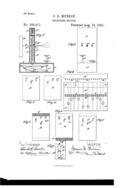
US Patent 246,411 (1881)
US patent 246,411, "Selecting Device." Issued 1881-08-30 to James E. Munson. Filed 1881-01-03. Expressed in modern terms, this is a chord keyboard. It does employ punched cards, but they are not used for data storage. Each key is permanently connected to a card, which has a pattern of holes unique to it. One or more keys are pressed simultaneously, each activating its card. The holes in the card are arranged such that for each combination of keys the holes will line up in only one location. The output (mechanical or electrical) is made by a pin registering that hole.
The only typesetting machine referenced by this patent is one by Adam Millar, of US patent 168,044 (1875-09-21); this machine is not mentioned in Huss. However, Munson references this present patent in his typesetting machine patent 320,271, below. Since 320,271 was filed in May of 1882, that indicates a period from January 1881 through May 1882 for the origin of Munson's typesetting machine.
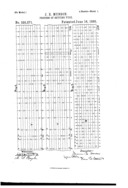
US Patent 320,271 (1882/1885)
US patent 320,271, "Process of Setting Type." Issued 1885-06-16 to James E. Munson. Filed 1882-05-23; application renewed 1885-03-18. Not assigned.
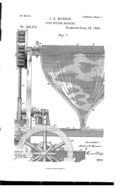
US Patent 320,272 (1882/1885)
US patent 320,272, "Type-Setting Machine." Issued 1885-06-16 to James E. Munson. Filed 1882-09-09. Application renewed 1885-03-18.

GB Patent No. 7,635 of 1884
(Listed by Legros & Grant as "Munson, J.E. Typesetting machine; Jacquard system.")

US Patent 328,600 (1885)
US patent 328,600, "Electrical Perforator." Issued 1885-10-20 to James E. Munson. Filed 1883-01-18, filing renewed 1885-03-18. Application serial number 159,307. This "electrical perforator" is what would later come to be called a "reperforator" in Teletype/Teletypesetter practice: A device which takes as input an electrical signal and punches a tape as output.
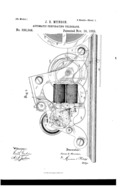
US Patent 330,344 (1885)
US patent 330,344, "Automatic Perforating-Telegraph." Issued 1885-11-10 to James E. Munson. Filed 1883-01-18 as application serial number 82,250.
Note: This patent refers to a patent application for a perforator by Munson filed 1882-08-05 as application serial number 68,548. I have not yet been able to discover any patent with this application number. However, Munson's US patent 332,419 for a "Perforating-Machine" was filed on that date (August 5, 1882). The application serial number of this Perforating-Machine patent, as issued, was 179,409. However, this Perforating-Machine patent application was renewed (1885-10-09) before being issued. I do not know enough about historical US patent office practices to know for certain if the application received a new serial number upon renewal, but it is plausible that it did.
The telegraphic system described here is one of synchronous transmission. The problem with all such systems, of course, is keeping them synchronized. In the successful systems which dominated much of the 20th century, this was overcome by the start-stop method of (re)synchronization of Howard Krum (US patent 1,286,351, filed 1910-05-31 and issued 1918-12-03). Munson's patent addresses this issue with an interesting attempt at resynchronizing the mechanisms with each character.

US Patent 332,419 (1885)
US patent 332,419, "Perforating-Machine." Issued 1885-12-15 to James E. Munson. Filed 1882-08-05. Application renewed October 9, 1885. Application serial number 179,409. This is an electromechanical keyboard perforator adapted to punch variably-spaced tapes.
This patent is of particular interest with regard to Munson's use of unit-set types. The keyboard as described is designed to handle conventional non-unit-set types, but the additional provisions necessary to accomodate them contribute to the complexity of the machine. As Munson notes, the problem is that "The differences in the running width of the various types used in ordinary composition are so numerous and many of them so slight that in order to proportion the feed of the band of paper [the tape] sufficiently near to the running widths of the type represented, it is required that the mechanism be capable of imparting feed-movements of numerous lengths varying only slightly from each other."
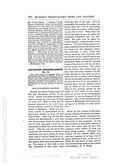
Phonographic News (1885)
"Advanced Writing-Lesson No. 18 / New Type-Setting Machine" Munson's Phonographic News and Teacher. Vol. 4, No. 7, Whole No. 55 (January 1885):
This is a reprint of an article from the New York World which is used as a writing lesson in Munson's journal. What is interesting in the present context is not its value as a shorthand teaching exercise but rather its content. It is clearly a description of Mergenthaler's second band machine. It is of course interesting that it was in 1885 that Munson appears to have revived his earlier efforts at typesetting machinery, but whether his knowledge of Mergenthaler's efforts prompted this or whether he learned of it as a consequence of his renewed interest in the field is impossible to know.
Digitized by Google from the NYPL copy, but not available for download from Google. It is available for limited download via The Hathi Trust (Hathi ID: nyp.33433033969647). The icon at left links to a PDF of this page from Hathi.
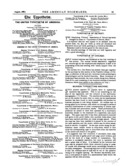
American Bookmaker (Aug. 1888)
"Munson Typesetting Machine." The American Bookmaker . Vol. 7, No. 2 (August 1888): 51. This brief article is significant because it confirms Munson's use of unit-set type at this point in time. ("One strong objection to the new machine is that the ordinary style of type will be out of the qustion owing to its irregular spacing. Mr. Munson has devised, however, a new system of types on a mathematical basis which his machine will set with accuracy.")
Digitized by Google from the University of Michigan copy. The icon at left links to a PDF of the page containing this article, extracted from that digitization.
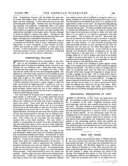
American Bookmaker (Nov. 1888)
"Munson Typesetting Machine." The American Bookmaker . Vol. 7, No. 5 (November 1888): 145. This verry brief trade note contains no new technical information, but does indicate that "The exhibitions given [of Munson's system] were satisfactory, but it will be some time before the invention can be used, the present machine being merely experimental." It also indicates that Munson "conceived [his machine] nearly seven years ago [thus ca. 1881]" but that "work has been steadily prosecuted for about four years." This fits with the gap between the filing and the issue dates of Munson's patents.
Digitized by Google from the University of Michigan copy. The icon at left links to a PDF of the page containing this article, extracted from that digitization.
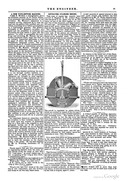
The Engineer [NY] (1888)
"A New Type-Setting Machine." The Enginner [NY]. New Series of 1883, Vol. 16, No. 7 (Oct. 6, 1888): 77. A report of a public demonstration by Munson. Article reprinted in The Engineer from the New York Times.
This brief news item contains several technical details. It indicates that Munson's keyboard was "like that of an ordinary typewriter" but that it must be some kind of a chord keyboard (as it speaks of 1,013 possible key combinations). It indicates that the operator performs justification with "a hand tool." It also contains says that Munson did not use this keyboard and tape apparatus with his own typesetter, but rather with the Thorne. I am presently aware of no indication in the surviving literature on the Thorne of any connection of the developers of that machine with Munson. It is tantalizing, as well, to note that Munson is reported to be considering "compressed air as a motive power" (shades of the Monotype!)
Digitized by Google from the University of Michigan copy. The icon at left links to a PDF of the page containing this article, extracted from that digitization.
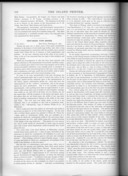
"Unit-Made Type Bodies" (1889)
Munson, James E. "Unit-Made Type Bodies." [letter to the editor in] The Inland Printer. Vol. 6, No. 6 (March, 1889): 512-513.

The Munson Method of Power Type-Composition
Munson, James E. The Munson Method of Power Type-Composition. (NY: James E. Munson, 1891). This is a sort of a prospectus by Munson for his machines. It still speaks of them in the future tense ("it will prove to be), and at times in the language of patents rather than products ("Means for...")
The machines described in this "prospectus" (if it might be called that) for Munson's system differ in several ways from those of his earlier patents. (I am unaware of any patents for these 1891 machines.) It shows a tape which differs in its coding from that of his 1882 patents, and which looks curiously similar to later 7-bit punched tape. It now has a central line of feed holes and the tape coding employs at least combinations of one, two, or three punches (rather than exactly three punches, as in his 1882 tape). (p. 10) While Munson says that it is still possible to do corrections on-tape in his system (p. 12), he describes as a preferred method the making of corrections in the set type (just as printers had always made corrections) (p. 11). He notes that his machine no longer requires unit-set type, but uses "ordinary type made and sold by all type-founders." (p. 12) The reason he gives for this is not the reduction in complexity of mechanism (as one might have suspected from the additional complexity of mechanism in his patent 332,419) but rather the introduction of an automatic justifying machine (which freed the compositor from the task of justifying by hand). (p. 12) He proposes typesetting machines capable of setting two sizes of type at once (p. 13). By way of contrast, each of the then-successful Thorne/Simplex typesetting machines was limited to a single size. The Mergenthaler Linotype could handle multiple sizes, but only one at a time. He also proposes "The Munson Power Type-Distributor, [which] when completed, will be greatly superior to any that has yet been constructed." (p. 13) This is an example of what has come to be known today as "vaporware." Finally, he still proposes the telegraphic transmission of composed text (pp. 20, 25), although this capability is not the focus of the system as it was in his 1888 demonstrations.
It is interesting to note that Munson's address is given as the Tribune Building in New York. The Tribune was of course the newspaper of Whitelaw Reid, sometime backer of the Linotype and Mergenthaler's nemesis. It is tantalizing to speculate on a connection, but by 1891 the Linotype in essentially modern form was already in production.
Digitized from a University of California copy and available at The Internet Archive. The icon here links to that presentation. For convenience, here are local copies of the PDF version ( munsonmethodofpo00muns.pdf) and the DjVu version ( munsonmethodofpo00muns.djvu).
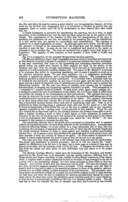
Modern Mechanism (1895)
Benjamin, Park, ed. Modern Mechanism: Being a Supplementary Volume to Appleton's Cyclopædia of Applied Mechanics . (NY: D. Appleton and Company, 1895). Digitized by Google from the University of Michigan copy.
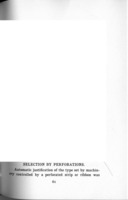
Thompson (1904)
Extract of the section "Selection by Perforations" from Thompson, John S. History of Composing Machines (Chicago: The Inland Printer Company, 1904): 61-62.
{10 choose 3} I nearly failed combinatorics in college. But my mathematical friends tell me that calculating the number of characters that Munson could encode with his system is an application of the "choose" function. You have 10 possible things (the 10 punch positions). You will choose exactly three of them. To a mathematician, working abstractly, the order doesn't matter (so choosing punch positions (1, 3, 7) is the same as choosing punch positions (3, 7, 1)). The function "n choose k" may be calculated as:
10! / ( 3! * (10 - 3)! ) = 120
{Huss 1973} Huss, Richard E. The Development of Printers' Mechanical Typesetting Methods, 1822-1925. (Charlottesville, VA: By the University Press of Virginia for the Bibliographical Society of the University of Virginia, 1973.)
{Janssen 2010} Janssen, Barbar Suit. "Patent Models Index: Guide to the Collection of the National Museum of American History, Smithsonian Institution" in Smithsonian Contributiosn to History and Technology. No. 54. (Washington, DC: The Smithsonian Institution, 2010). In two parts: Vol. 1 ("Listings by Patent Number and Invention Name") and Vol. 2 ("Listings by Inventor and Residence of Inventor").
{NEI 1911} Gilman, Daniel Coit, Harry THurston Peck, and Frank Moore Colby, eds. The New International Encyclopedia. Vol. 14. (NY: Dodd, Mead and Co., 1911). Digitized by Google from a University of California copy.
{Thompson 1904} Thompson, John S. History of Composing Machines. (Chicago: Inland Printer Company, 1904.)
US patent specifications are in the public domain by law.
The volumes of The American Bookmaker, The Inland Printer, The Engineer (NY), and Munson's Phonographic News and Teacher, Modern Mechanism (1895), and Munson's The Munson Method of Power Type-Composition are in the public domain due either to failure to comply with copyright filing or renewal technicalities or the expiration of all possible copyright or both. Their digitizations here remain in the public domain.
Thompson's History of Composing Machines is in the public domain due to the expiration of all possible copyright. The digital extract from it here, scanned by me from an original copy, remains in the public domain.
All portions of this document not noted otherwise are Copyright © 2013 by David M. MacMillan and Rollande Krandall.
Circuitous Root is a Registered Trademark of David M. MacMillan and Rollande Krandall.
This work is licensed under the Creative Commons "Attribution - ShareAlike" license. See http://creativecommons.org/licenses/by-sa/3.0/ for its terms.
Presented originally by Circuitous Root®
Select Resolution: 0 [other resolutions temporarily disabled due to lack of disk space]